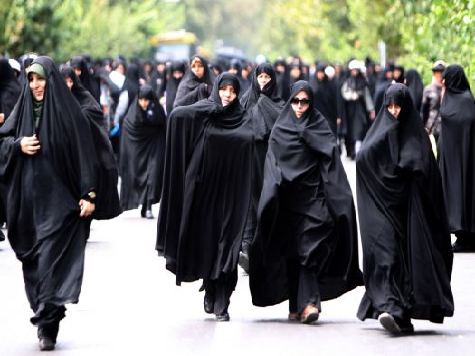They rape and torture women in Iran: First, at home, as a family matter; then in prison, as a state matter.
They publicly execute women for daring to kill their attackers in self-defense. It is public in order to terrify and sicken others, shame them, make them know that they are really, truly helpless, have them understand that when the authorities come for them, no one will intervene on their behalf. A public execution is a fine way to keep a civilian population permanently cowed.
And yet, there are things that will not allow one to go on, brutalities on a daily basis that are, perhaps, even more sickening than a public execution.
Rayhana Jabbari has been sentenced to hang for the crime of killing the man who was attempting to rape her. She has already been in jail for seven years. Even the United Nations has called for a “fair trial.” Her execution was postponed but she remains in danger of being hung at any moment.
As does an Iranian child bride, Razieh Ebrahimi, married at 14, and who now faces imminent execution for killing her violent and abusive husband when she was 17 years-old. She has been languishing in prison for the last four years.
Farzana Moradi was also accused of murdering her husband. She was married to him when she was 15, became a mother at 16, and wanted “out” by the time she was nineteen. “Out” did not exist for her. “Out” meant killing her husband. Despite an international campaign on her behalf, the Islamic Republic of Iran hung her on March 4, 2014. Farzana was 26 years old.
Interestingly enough, if a murderer’s family is willing to pay “blood money,” the victim’s family has the power to spare his life. This is true, even in Iran. Safar Anghouti’s family raised fifty thousand dollars via an internet campaign–and he was freed.
I am not familiar with a woman’s family buying up her life or a murdered man’s family accepting money for his death.
Iran is the world’s most notorious executioner of children. They hang homosexuals. They routinely rape female and male prisoners.
Iran is developing nuclear power while the world whistles Dixie. Iran is also a member state of the United Nations and sit on the Disarmament and International Security Committee as its Rapporteur.
Our government believes it can and must make alliances with this country–the same country that has threatened Israel with genocide and has funded Hezbollah, its Islamist striking force in both the Arab Middle East and in South America.
The United States did not act to support The Greens when they marched in Teheran and both they and we will surely reap the whirlwind.
I was first in Teheran in 1961, when I was on my way to visit Kabul. The Iranian women whom I met were elegant and sophisticated. They wore expensive western clothing and perfume, smoked cigarettes, talked in French and English. No one was veiled.
Yes, the poverty was shocking–but still, the smells of the bazaar were enchanting, both ancient and familiar, and I loved the food, the architecture and the wide open sky.
Fifteen years later, I was involved with an organization known as CAIFI, Students Against the Shah. Their leader, Reza Baraheni, an author and intellectual, had a standard talk about having been tortured by SAVAK because he had opposed the monarchy and yearned for liberation.
Eighteen years later, my friends, Kate Millett and Sophie Kier, were in Iran for International Women’s Day. Khomeini had come to power and guess what? He arrested the two feminists. For days, we agonized about how to get them out. Amazingly, Khomeini decided to let them go!
Meanwhile, my friend Reza had flown home, ecstatic about the possibility of “freedom.” The very next year, he invited me to Teheran to speak on International Woman’s Day. “You understand the Muslim soul, you can bring feminism in a soft and feminine way.” Needless to say, I did not go and within years, Reza himself was lucky enough to flee the Monster Mullah regime and found asylum in Canada.
Today, the women are garbed in fierce black. They scowl. They are forced to wear chadors while on bicycles and in swimming pools.
And yet: The Iranian women I have met who live in exile are exceptionally feisty and fierce for freedom. They claim Zoroastrian roots, as well as Ba’hai, Jewish, and Muslim roots. In general, they are very accomplished women.
Once, I was asked to join a panel of Iranian and Afghan women associated with the United Nations. Although I had vowed never to return there, I yielded to their request. As the panel began, a force of six to eight Iranian women all in heavy black chadors came in and sat down all in one row in intimidation battle readiness. One of the Iranian women panelists immediately jumped up, pointed them out, pointed to them and then said: “We know who you are. We know why you are here. You do not scare us and you cannot silence us. Just tell your Masters back in Teheran that, one day, women will bring them down.”
I was stunned and impressed. Shortly thereafter, the Iranian women, on a signal from their leaders, all walked out.
Oh, how I wish our government would take a lesson from this brave Iranian women panelist and behave in similar ways.

COMMENTS
Please let us know if you're having issues with commenting.